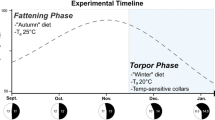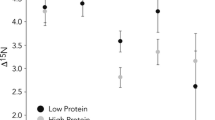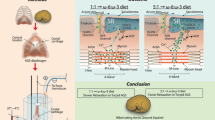Summary
Dieary lipids strongly influence the pattern of torpor and the body lipid composition of mammalian hibernators. The object of the present study was to investigate whether these diet-induced physiological and biochemical changes also occur in species that show shallow, daily torpor. Deer mice, Peromyscus maniculatus, were fed with rodent chow (control diet) or rodent chow with either 10% sunflower seed oil (unsaturated diet) or 10% sheep fat (saturated diet). Animals on the unsaturated diet showed a greater occurrence of torpor (80–100% vs 26–43%), longer torpor bouts (4.5 vs 2.25 h), a lower metabolic rate during torpor (0.96 vs 2.25 ml O2·g-1·h-1), and a smaller loss of body mass during withdrawal of food (2.35 vs 3.90 g) than animals on the saturated diet; controls were intermediate. These diet-induced physiological changes were associated with significant alterations in the fatty acid composition of depot fat, leg muscle and brain total lipids, and heart mitochondrial phospholipids. Significant differences in the total unsaturated fatty acid (UFA) content between animals on saturated and unsaturated diet were observed in depot fat (55.7% vs 81.1%) and leg muscle (56.4% vs 72.1%). Major compositional differences between diet groups also occurred in the concentration of n6 and/or n3 fatty acids of brain and heart mitochondria. The study suggests that dietary lipids may play an important role in the seasonal adjustment of physiology in heterothermic mammals.
Similar content being viewed by others
Abbreviations
- EDTA:
-
ethylenediaminetetra-acetic acid
- HEPES:
-
N-2 hydroxyethylpiperazine-N1-2-ethanesulphonic acid
- MUFA:
-
monounsaturated fatty acids
- PUFA:
-
polyunsaturated fatty acids
- RMR:
-
Testing metabolic rate
- SD:
-
standard deviation
- SFA:
-
saturated fatty acids
- SNK:
-
Student-Newman-Keuls test
- T1 :
-
air temperature
- Tb :
-
body temperature
- UFA:
-
unsaturated fatty acids
- \(\dot VO_2 \) :
-
rate of oxygen consumption
References
Aloia RC (1979) Membrane structure and function during hibernation. Chem Zool 11:49–75
Aloia RC, Pengelley ET (1979) Lipid composition of cellular membranes of hibernating mammals. Chem Zool 11:1–48
Aloia RC (1988) Lipid, fluidity and functional studies of membranes of hibernating mammals. In: Aloia RC, Curtain CC, Gordon LM (eds) Physiological regulation of membrane fluidity. Liss, New York, pp 1–39
Aloia RC, Raison JK (1989) Membrane function in mammalian hibernation. Biochim Biophys Acta 988:123–146
Augee ML, Pehowich DJ, Raison JK, Wang LCH (1984) Seasonal and temperature-related changes in mitochondrial membranes associated with torpor in the mammalian hibernator Spermophilus richardsonii. Biochim Biophys Acta 776:27–36
Barnes BM (1989) Freeze-avoidance in a mammal: body temperatures below 0°C in an Arctic hibernator. Science 244:1593–1595
Bligh EC, Dyer WJ (1959) A rapid method of total lipid extraction and purification. Can J Biochem Physiol 37:911–917
Cossins AR, Friedlander MJ, Prosser CL (1977) Correlations between behavioral temperature adaptations of goldfish and the viscosity and fatty acid composition of their synaptic membranes. J Comp Physiol 120:109–121
Cossins AR, Bowler K (1987) Temperature biology of animals. Chapman and Hall, London
Fawcett DW, Lyman CP (1954) The effect of low environmental temperature on the composition of depot fat in relation to hibernation. J Physiol (Lond) 126:235–247
Florant GL, Nuttle LC, Mullinex DE, Rintoul DA (1990) Plasma and white adipose tissue lipid composition in marmots. Am J Physiol 258:R1123-R1131
Fowler PA, Racey PA (1990) Daily and seasonal cycles of body temperature and aspects of heterothermy in the hedgehog Erinaceus europaeus. J Comp Physiol B 160:299–307
Geiser F (1990) Influence of polyunsaturated and saturated dietary lipids on adipose tissue, brain, and mitochondrial membrane fatty acid composition of a mammalian hibernator. Biochim Biophys Acta 1046:159–166
Geiser F, Baudinette RV (1987) Seasonality of daily torpor and thermoregulation in three dasyurid marsupials. J Comp Physiol B 157:335–344
Geiser F, Kenagy GJ (1987) Polyunsaturated lipid diet lengthens torpor and reduces body temperature in a hibernator. Am J Physiol 252:R897-R901
Geiser F, Augee ML, Raison JK (1984) Thermal response of liver mitochondrial membranes of the heterothermic bat Miniopterus schreibersii in summer and winter. J Thermal Biol 9:183–188
Geiser F, Hiebert S, Kenagy GJ (1990) Torpor bout duration during the hibernation season of two sciurid rodents: Interrelations with temperature and metabolism. Physiol Zool 63:489–503
Goldman SS (1975) Cold resistance of the brain during hibernation. III Evidence for a lipid adaptation. Am J Physiol 228:834–839
Hazel JR (1984) Effects of temperature on the structure and metabolism of cell membranes in fish. Am J Physiol 246:R460-R470
Hazel JR (1988) Homeoviscous adaptation in animal cell membranes. In: Aloia RC, Curtain CC, Gordon LM (eds) Physiological regulation of membrane fluidity. Liss, New York, pp 149–188
Heldmaier G, Steinlechner S (1981) Seasonal pattern and energetics of short daily torpor in the Djungarian hamster, Phodopus sungorus. Oecologia 48:265–270
Howard WE (1961) Seeds stored by prairie deer mice. J Mammal 42:260–263
Hudson JW (1973) Torpidity in mammals. In: Whitow GC (ed) Comparative physiology of thermoregulation. Academic Press, New York, pp 97–165
Hudson JW, Scott JM (1979) Daily torpor in the laboratory mouse Mus musculus var. albino. Physiol Zool 52:205–218
Lehninger AL (1982) Principles of biochemistry. Worth, New York
Lepage G, Roy CC (1986) Direct transesterification of all classes of lipids in a one-step reaction. J Lipid Res 27:114–120
Lynch GR, Vogt FD, Smith HR (1978) Seasonal study of spontaneous daily torpor in the white-footed mouse Peromyscus leucopus. Physiol Zool 51:289–297
McMurchie EJ (1988) Dietary lipids and the regulation of membrane fluidity and function. In: Aloia RC, Curtain CC, Gordon LM (eds) Physiological regulation of membrane fluidity. Liss, New York, pp 189–237
Montaudon D, Robert J, Canguilhem B (1986) Fluorescence anisotropy of kidney lipids and membranes of a hibernating mammal. Cryobiology 23:177–183
Morhardt JE (1970) Body temperatures of white-footed mice (Peromyscus spp.) during daily torpor. Comp Biochem Physiol 33:423–439
Raison JK (1984) On the need to distinguish between the essential and consequential changes in membrane lipids during hibernation. In: Hales JRS (ed) Thermal physiology. Raven Press, New York, pp 447–452
Raison JK, Augee ML, Aloia RC (1988) Mitochondrial membrane transitions in heart and other organs of a hibernator. Am J Physiol 254:E378-E383
Sokal RR, Rohlf FJ (1981) Biometry. Freeman, New York
Tannenbaum MG, Pivorun EM (1984) Differences in daily torpor patterns among three southeastern species of Peromyscus. J Comp Physiol B 154:233–236
Wang LCH (1989) Ecological, physiological, and biochemical aspects of torpor in mammals and birds. In: Wang LCH (ed) Animal adaptation to cold. Springer, Berlin, Heidelberg, pp 361–401
White DA (1973) The phospholipid composition of mammalian tissues. Biochim Biophys Acta Library 3:441–483
Wiersinga WM, Chopra IJ, Chua Teco GN (1988) Inhibition of nuclear T3 binding by fatty acids. Metabolism 37:996–1002
Author information
Authors and Affiliations
Additional information
Dedicated to the late John K. Raison
Rights and permissions
About this article
Cite this article
Geiser, F. The effect of unsaturated and saturated dietary lipids on the pattern of daily torpor and the fatty acid composition of tissues and membranes of the deer mouse Peromyscus maniculatus . J Comp Physiol B 161, 590–597 (1991). https://doi.org/10.1007/BF00260749
Accepted:
Issue Date:
DOI: https://doi.org/10.1007/BF00260749




